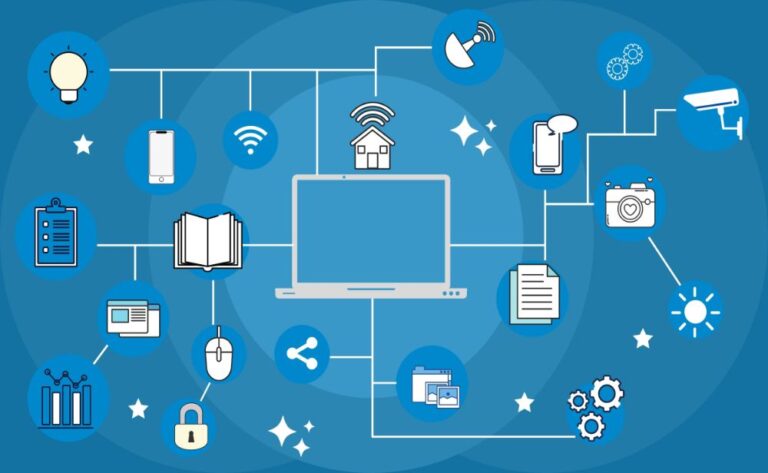B2B Digital Marketing For Beginners (Complete Guide)
Businesses that offer goods and services to other enterprises are known as business-to-business (B2B) organizations. These organizations, like any business, rely on marketing to get their products in front of buyers.
You’ll discover what B2B marketing is, how it differs from b2c marketing, and the top b2b marketing tactics to implement right away for the greatest outcomes in this beginner’s guide to B2B digital marketing.
B2B digital marketing: What is it?
B2B digital marketing is a type of marketing strategy in which companies promote their goods and services to other businesses using digital channels. Websites, emails, and social media platforms are just a few examples of the channels that can be used as part of the marketing strategy.
A successful B2B digital marketing strategy requires educating businesses about your brand and promoting the benefits of your goods and services in order to persuade them to become clients.
The B2B marketing method is specially created to handle the challenges of selling to other businesses.
Comparing B2C and B2B marketing
B2C focuses consumers, while B2B targets decision-makers.
Audience targeting is where B2B and B2C marketing diverge most.
Clearly, B2C marketing focuses on specific customers. However, B2B focuses on corporate decision-makers. This can be done by a team or a single person for each organization.
Since these parties are making decisions on behalf of the organization, the corporation is the ultimate customer even if B2B still entails marketing to people.
As a result, buyers in the business-to-business sector make more rational choices and are less influenced by their emotions.
Compared to B2C sales, B2B sales have longer sales cycles and require more time to close. Consumers usually make impulsive purchases without doing any study, but B2B buyers typically take months to consider their needs and available options before making a purchase.
B2C marketing focuses on high-volume head keywords, while B2B marketing targets long-tail keywords.
Search engine traffic is a significant component of both B2C and B2B marketing. The keywords that various marketing techniques aim to target, however, range significantly.
Short keywords with lots of search volume will be the emphasis of B2C marketing.
On the other hand, B2B marketing places a strong emphasis on long-tail, lower-volume keywords. This is due to the fact that business purchasers’ searches are more focused than consumers’ broad queries.
Paid advertising costs more in B2B than in B2C.
Comparing B2B sales to sales to consumers, the average value of B2B sales is significantly larger. This makes logical because businesses have far higher requirements and more money to spend.
These businesses are prepared to spend more on advertising because B2B transactions increase income.
As a result, B2B marketers’ cost-per-click (CPC) for ads is much higher.
In-depth, data-driven content creation is key to B2B marketing.
Both B2B and B2C marketing utilize content as a component of their marketing strategy, but in unique ways.
B2C businesses might produce content that is solely meant to sell to or captivate their audience.
To engage their audience, B2B marketers must offer comprehensive, data-driven, and authoritative content.
More important factors in securing a transaction are offering value and demonstrating expertise.
For B2B marketing, professional social media networks are more appropriate.
Social media platforms are crucial for both B2C and B2B businesses. However, the two frequently concentrate on various platforms.
The most effective platforms for B2C marketing include Facebook, Tik Tok, and Instagram because of their broad user bases.
A professional site like LinkedIn is more effective for B2B. Additionally, Twitter is a better medium for organizations wishing to network with and do business with other businesses and professions.
For B2B marketing, direct communication is still a fantastic sales channel.
B2C sales and marketing are impersonal. Businesses don’t know the people who are purchasing their goods, and there is little to no direct interaction between the two parties.
But in a business-to-business transaction, the buyer and the seller frequently have direct contact. Leads are frequently nurtured by businesses for weeks before they turn into sales.
Usually, this is done via email, although it can also occasionally be done via phone.
10 Top B2B Marketing Techniques
1. Gain expertise in B2B SEO
2. Expand your network on LinkedIn
3. Examine LinkedIn Paid Ads.
4. Establish relationships on Twitter
5. Implement Brand Awareness Programs
6. Use Retargeting Campaigns to Generate Leads
Send a newsletter with industry updates 7. Create a YouTube channel 8.
9. Utilize Google Ads
10. Collaborate with other companies
1. Gain expertise in B2B SEO
89% of B2B decision-makers use the internet to research and find items, according to Google study. Many of these businesses conduct their research using search engines like Google when they go online.
As a result, search engines are among the most significant routes for company acquisition. Due to this, it is crucial for B2B businesses to rank their website highly for the search terms that their prospective clients use.
The marketing tactic known as search engine optimization (SEO) is used to raise rankings and increase traffic from online users.
The search for B2B SEO keywords
Comprehensive keyword research is necessary for the implementation of a successful B2B SEO plan. Finding the precise search phrases that clients are using is done in this manner. With this information, you are aware of the topics for which to write pages and content.
At every level of the digital marketing funnel, it’s critical for B2B marketers to identify the keywords that their target market is utilizing. This covers the awareness phase, in which prospects initially engage with you, and the conversion phase, in which the prospect turns into a client.
B2B marketers must additionally target informational questions, such as “how to utilize a project management software,” but B2C marketers can get away with concentrating only on commercial phrases (e.g., “purchase protein powder”).
Remember that these long-tail, lower-volume keywords will receive greater attention in B2B SEO. For the purpose of making a decision, a buyer must conduct these searches to acquire information.
Businesses that offer value at this point in the sales funnel have a higher chance of converting the consumer into a customer.
Content marketing is the most effective strategy to target long-tail keywords while adding value.
Here are some examples of how content marketing may be used for B2B SEO:
Make detailed guides
One of the best B2B content formats for SEO is in-depth tutorials. Decision-makers routinely look for data to assist them in doing their duties. A fantastic strategy to get your business on their radar is to provide comprehensive content that responds to all of their inquiries.
Additionally, B2B buyers require assurance that the businesses they do business with are reputable authorities in their industry.
Your business will be given greater thought when it comes time to make the final purchase choice.
Blogging about B2B-related subjects
Another strategy to position your company as an authority is to frequently write issues about your industry on your blog.
Prospects will frequently visit your website to remain up to date on the latest developments if your blog is a reliable, relevant source of information.
Additionally, many readers will spread your information among their colleagues, enhancing your visibility and strengthening your reputation as an industry thought leader.
2. Expand your network on LinkedIn
The most effective social media channel for businesses to business is LinkedIn.
The platform is excellent for assisting professionals in connecting with their peers to expand their business network because it was created exclusively for businesses and the people who work for them.
Building a network is crucial because the connections you make could result in more business for your firm. This could involve referrals of other businesses that would make excellent prospects or customers from your network.
According to LinkedIn, the platform generates 80% of all B2B marketing leads.
In addition to having a large user base, LinkedIn also attracts key decision-makers with whom B2B marketers must interact. According to internal LinkedIn research, 63 million people use the platform as decision-makers.
In addition to networking, LinkedIn has a significant organic reach. You can improve the relationship with your network and draw attention to your solution among potential customers by providing material on LinkedIn.
Writing articles expressly for LinkedIn and their network on the platform, many B2B marketers frequently do so.
Virtual events are a fantastic way to interact with your audience. You may run online workshops and seminars using the LinkedIn Events feature. After that, you can invite the people you wish to come.
If the event is successful, it might lead to extra LinkedIn connections for your profile.
3. Examine LinkedIn Payed Ads
LinkedIn may be used for more than just content sharing and professional networking when trying to reach B2B customers.
Additionally, the network features a strong advertising platform that works wonders for generating leads and boosting revenue.
For B2B marketers, LinkedIn Ads offer unmatched targeting. People might be targeted based on their education, membership groups, work history, abilities, and other factors.
Since LinkedIn is the preferred professional networking site, many users keep their profiles current, resulting in very accurate data for ad targeting.
This makes it a terrific way to expose your organization to the people who are most likely to become customers.
Configuring LinkedIn Ads
For the purpose of producing B2B leads, there are a number of LinkedIn ad formats that work well.
On LinkedIn, the right-sidebar has text adverts, which are straightforward advertisements. These advertisements have a logo and a few words of text.
Then there are numerous ad forms for sponsored content, such as carousel ads, single image ads, and video commercials. The organic content from the users’ relationships and groups is mixed in with these advertising in the users’ news feeds.
Utilizing Sponsored InMail ads that show up in people’s LinkedIn messaging inboxes, you can also directly approach people using LinkedIn.
Each of these advertising efforts is more suitable for a particular stage in the connection with a consumer, so a B2B advertising strategy frequently combines all of them.
For instance, someone who has interacted with your company a few times is better suitable for a Sponsored InMail message.
You should use concise, captivating language that is pertinent to your target demographic if you want your advertisements to be as effective as possible. Utilize your current assets by spreading the word about your blog posts and other material that generates leads.
4. Create relationships on Twitter
Twitter is a fantastic tool for networking with other business people, much like LinkedIn. The platform makes it simple to connect with people who share your interests, and you can easily build an engaged following.
You wish to communicate and follow key players in your field. To contribute your thoughts and advance the discussion, you can like, retweet, and comment on their tweets.
To grow your community even further, it’s a good idea to see who these individuals are following and follow them as well.
Tweets from businesses
Twitter’s character limit makes it more appropriate for sharing links to external websites and brief interactive material than it is for posting lengthy prose.
Additionally, it’s critical to publish frequently on the platform because B2B viewers are more likely to interact with a recognized face.
A B2B user who has seen your messaging four times is 335% more likely to click the link in a Tweet than a user who has only seen it once, per Twitter Data.
Although you should post frequently, keep in mind that posts that are only promotional in nature can hinder your presence on the network. Try to add value to every conversation by sharing other information or offering insightful commentary.
The creation of original research is another strategy. Original research, in the opinion of B2B content marketers, is their most successful type of content, according to eMarketer.
Given that you can easily put multiple powerful data into a Tweet, this style of content complements Twitter’s short-form nature effectively.
5. Implement Brand Awareness Programs
Being aware of your brand is the first step in any business’ client journey. The B2B Institute states that brand building should account for 46% of a company’s marketing budget.
More than just having your logo and company name in front of your audience is involved in building brand awareness. You must present a clear picture of what your business offers and how you can help clients.
Campaigns that are both organic and paid should be used in B2B brand awareness initiatives.
LinkedIn is obviously a wonderful venue for B2B brand recognition as people are on the site with a business mindset. This indicates that they are more inclined to interact with your company’s content and advertisements and visit your website again to discover more about it.
6. Use Retargeting Campaigns to Generate Leads
Typically, it will take several conversations for a prospect to convert to a lead. B2B decision-makers are unlikely to submit a contact form right away for a service they’ve just learned about.
In reality, it takes at least 4 months to close over 75% of B2B sales to new clients, and it typically takes 6 to 8 touchpoints to convert a lead.
This implies you need a proactive strategy to re-engage consumers and inform them of your company.
Retargeting advertising provide you the ability to create a campaign that particularly targets past visitors to your website.
Due to the audience’s familiarity with your company, these campaigns may have higher conversion rates. As you may receive more value from your ad expenditure, this can result in more cost-effective marketing.
Because you have more knowledge about the interests of the audience, retargeting campaigns also enable you to be extremely particular with your messaging. You can use a retargeting ad to promote a certain product, for instance, if a user hits a product page repeatedly.
sites for retargeting advertisements
Running retargeting ad campaigns is an option provided by a number of retargeting services.
LinkedIn is the ideal platform for retargeting advertising because it is the best place to connect with B2B buyers.
You can establish “Matched Audiences” on LinkedIn using users who have visited your website or clicked on one of your LinkedIn Ads.
Another effective medium for B2B retargeting ads is Google. With Google remarketing, you can target viewers of display and video advertising who have already interacted with your website.
7. Distribute an industry newsletter
An email newsletter is excellent for building relationships with people both before and after they become clients.
Email provides a direct channel to prospective customers, and emails frequently receive a better response and engagement than advertisements.
This is because there is already some interest as one must first sign up to get your email newsletter.
Your email newsletter should aim to educate rather than only sell to your audience, similar to the content on your website.
90% of top-performing B2B content marketers prioritize the informational demands of their audience, according to OptinMonster.
Therefore, strive to create authority while fostering solid connections with both present and potential clients.
But bear in mind that B2B purchasers are time-constrained individuals, and many won’t have the patience to read lengthy emails. It’s best to send concise, easily readable emails.
Following are a few typical examples of how B2B marketers connect their audience through email newsletters:
Newest information
Your email newsletter can be used to inform your subscribers about happenings and changes in your sector.
Additionally, you can communicate updates about your company’s products and features.
For instance, the project management tool ClickUp sends out weekly ClickUpdates emails with links to forthcoming seminars and new feature releases.
Share and repurpose material
Email messages benefit greatly from repurposed material, such as blogs, podcasts, webinars, and social media posts. You can use these to provide the same advice in a more streamlined format.
By doing this, you may save time and reach a larger audience with your most important resources.
You might submit summaries of your most recent postings or summaries of case studies and customer testimonials, for instance.
8. Start a YouTube channel
While email newsletters and blogs have been tried-and-true B2B marketing tactics for years, many B2B marketers are increasingly utilizing video platforms like YouTube to engage with their audience and generate interest in their products.
Many decision-makers utilize the site, which is the second-largest search engine behind Google, to locate in-depth video information relevant to the main problems facing their companies.
You may effectively educate your audience about your items by using YouTube videos. You may make explainer films and how-to lessons on YouTube that walk viewers through your products’ features and proper usage.
This content is excellent for enhancing your blog’s content. You can make films that are pertinent to your postings and then embed them to supplement the text on the blog.
Make your videos YouTube-friendly SEO
Your videos won’t reach your target audience if they aren’t SEO-optimized.
Researching keywords is the first step in optimizing your video ranks, just like SEO for Google. Knowing the search terms that viewers enter will help you better target those terms with your videos.
By specifically targeting the search keyword and topic in the content itself, you will achieve this. You will also need to add the keywords to the title, tags, and hashtags of the video.
9. Utilize Google Ads
Keep in mind that Google is where B2B product and service research begins.
You may increase the size of your audience by using Google Search Ads in addition to an efficient SEO plan to help you appear in front of searchers.
When you use a Google Search Ad, your website will rank first for the precise keywords you choose in the campaign parameters.
Here are a few adverts for the keyword “crm system,” for instance.
Google Search advertisements help you draw clients who might not have found your website in the organic results otherwise. Additionally, they function well at every stage of the B2B buyer’s funnel.
You can choose to target terms for the awareness stage of the research process, such as “what is a product name” or “top companies in X industry.”
These advertisements might introduce potential customers to your brand. You can point them in the direction of a relevant blog post that provides the information.
You can concentrate your attention during the evaluation step on high-intent search phrases where the searcher clearly intends to make a purchase. For instance, questions like “how much do products cost?”
Keywords that contain a brand name of a rival company are another popular sort of targeting for B2B businesses.
10. Collaborate with other companies
B2B business alliances can be extremely advantageous for all sides. Working with other businesses can provide you the opportunity to build a network to reach new prospects and increase brand awareness, even though they can take some time to put together.
B2B marketing alliances can sometimes form naturally, but most of the time, one or both of the partners take direct action to make it happen.
You must be prepared to structure the partnership and know what you want to gain from it before approaching other companies about partnering.
Co-marketing agreements, where you exchange experiences to produce content, lead-sharing agreements, and delivering bundled products are a few examples of frequent arrangements. Many partnerships also provide clients with exclusive deals to purchase the items of the other company at lower prices.
You can collaborate with other B2B marketers in the following ways:
Run events
One of the best marketing tactics for B2B relationships is events. You can scale your event’s attendance with a co-host to accommodate a wider audience.
Additionally, you get to split the cost and have twice as many specialists present to provide participants with insightful information.
Webinars and content for lead generation
B2B collaborations are also quite helpful for producing lead generation materials like webinars. Companies can cooperate and pool their knowledge to produce more comprehensive content that is more beneficial to both audiences.
Launch a program for affiliates
Through affiliate marketing, businesses can benefit from the promotion of others’ goods.
With an affiliate program, you can collaborate with other businesses to have them suggest your consumers in return for a commission that is a percentage of the sales.
Conclusion
Despite its seeming complexity, B2B marketing may be successfully executed by following a few straightforward procedures.
Build your network on LinkedIn and Twitter, provide valuable content for your website, emails, and social media channels, and use sponsored ads to connect with and re-engage your audience.
These actions will go a long way toward introducing your company to your target market and eventually winning them over as clients.







